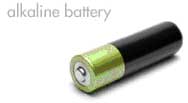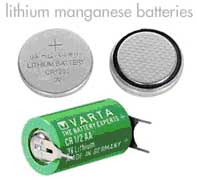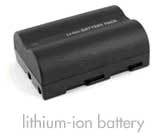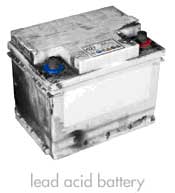Battery consumption is projected to grow annually 5.9% to $14.8 billion per year due to strong demand for battery-powered products like cellular phones and digital cameras and increasing production of electronic devices. Along with this growth comes added regulations pushed by environmental groups and many local, state and federal governments. Some of the toxic heavy metals in batteries include nickel cadmium, alkaline, mercury, nickel metal hydride and lead acid, which can threaten our environment if not properly discarded. Recycling programs are in place for all of these materials, so batteries should be recycled when ever possible. Not all batteries are the same and they require specific instructions to ensure each type of battery is properly discarded or recycled.
Alkaline Batteries
 These batteries have a long shelf life and retain about 90% of their capacity after two years. They also have good performance at high and low temperatures. According to the EPA, potassium hydroxide, a strong alkali, is contained within the cells of alkaline batteries. The potassium hydroxide can leak out of the battery cell if alkaline batteries are damaged or mishandled, which can cause severe chemical burns if the substance comes into contact with your skin or eyes.
These batteries have a long shelf life and retain about 90% of their capacity after two years. They also have good performance at high and low temperatures. According to the EPA, potassium hydroxide, a strong alkali, is contained within the cells of alkaline batteries. The potassium hydroxide can leak out of the battery cell if alkaline batteries are damaged or mishandled, which can cause severe chemical burns if the substance comes into contact with your skin or eyes.
Some batteries such as the alkaline battery have had about a 97 percent mercury reduction in the product. Mercury reduction in batteries began in 1984 and continues today. Newer alkaline batteries may contain about one-tenth the amount of mercury previously contained in the typical alkaline battery. Some alkaline batteries have zero-added mercury, and several mercury-free, heavy-duty, carbon-zinc (or zinc-carbon) batteries are on the market.
Because of the mercury reduction, some landfill bans of alkaline batteries and recycling programs taking them have ceased. When disposing of household alkaline batteries, it is best to check with your local and State Recycling or Household Hazardous Waste Coordinators concerning the specifics of your program.
Lithium Manganese Batteries
 Lithium batteries are mainly used as rechargeable batteries in computers, camcorders, laptops, cameras, and most products with a slim profile. Lithium ignites when in contact with water, so when these batteries are broken or destroyed, they become a serious fire hazard. Recycling lithium batteries not only diverts this potential disaster, it also deters pollution of our natural resources. One of the recycling processes currently available for lithium-containing batteries involves recovering the lithium in the battery and selling it back to battery manufacturers.
Lithium batteries are mainly used as rechargeable batteries in computers, camcorders, laptops, cameras, and most products with a slim profile. Lithium ignites when in contact with water, so when these batteries are broken or destroyed, they become a serious fire hazard. Recycling lithium batteries not only diverts this potential disaster, it also deters pollution of our natural resources. One of the recycling processes currently available for lithium-containing batteries involves recovering the lithium in the battery and selling it back to battery manufacturers.
Toxco, a recycling facility, freezes the batteries, then they are then safely shredded, and the materials are separated. Metals from the batteries are collected and sold. The lithium components are separated and converted to lithium carbonate for resale.
Zinc Chloride Batteries
These batteries are slowly being replaced with alkaline batteries. They don’t have long lives, and they don’t hold up well in high temperatures. They are less likely to leak and perform better at low temperatures than carbon-zinc batteries, however. They were considerably cheaper than alkalines and therefore preferred over alkaline batteries, but now the prices are comparable, so they are becoming less popular. The zinc from these batteries can be reprocessed, so look into your local recycling options.
Silver Oxide Batteries
Silver oxide (silver-zinc) batteries are round and come in two types: sodium hydroxide and potassium hydroxide. Sodium hydroxides last about two to three years and are recommended for analog digital watches without backlights, while potassium hydroxides are a better option for LCD watches with backlights. Silver is expensive, but these batteries are available in small sizes where the amount of silver used is so small it does not affect the price or in larger sizes where the superior performance of the battery outweighs the cost.
In addition to watches, silver oxide batteries are also found in hearing aids, calculators and pagers. These batteries contain mercury, so they are hazardous and should not be sent to a landfill. Mercury-oxide and silver-oxide button batteries are often collected by jewelers, pharmacies, and hearing-aid stores who sell them to companies that reclaim the metals. Like lithium batteries, the recycling/disposal process of these batteries involves shredding the batteries, neutralizing the electrolytes and recovering the heavy metals.
Nickel-Cadmium Batteries (NiCd)
These batteries are used in low- to moderate-discharge devices such as scanners and portable radios. Since these batteries contain cadmium, a toxic heavy metal, they require special disposal. In the United States, there is a fee built into the price for nickel cadmium batteries which includes proper disposal of the batteries at the end of their lifetimes. All NiCd batteries are identified by the EPA as hazardous waste and must be recycled. The recycling process recovers cadmium and iron-nickel for steel production.
Nickel-Metal Hydride Batteries (NiMH)
The main difference between this battery and the NiCd battery is the metal hydride used instead of the cadmium. Nickel-metal hydride batteries are also available in the standard cylindrical sizes. These batteries also have two to three times the capacity of a nickel-cadmium, and the memory effect is not as significant. Memory effect is when a battery’s maximum energy capacity gradually decreases as a result of being recharged before the battery has completely discharged.
Nickel-metal hydride batteries are commonly used in high-discharge devices like portable power tools, digital cameras and laptops. They are considered non-hazardous waste, but do contain elements that can be recycled. The individual materials of the batteries are mechanically separated, and high nickel content is produced and used in the manufacture of stainless steel.
Lithium-Ion and Lithium-Ion Polymer Batteries
 These batteries only come in rectangular or cylindrical shapes. There is no issue of a memory effect with these batteries, meaning they can be recharged before they are completely discharged without affecting the energy capacity. They are smaller, lighter and provide more energy than nickel cadmium or nickel-metal hydride batteries.
These batteries only come in rectangular or cylindrical shapes. There is no issue of a memory effect with these batteries, meaning they can be recharged before they are completely discharged without affecting the energy capacity. They are smaller, lighter and provide more energy than nickel cadmium or nickel-metal hydride batteries.
Lithium batteries are most often used in cell phones and mobile computing devices. They should not be stored in hot cars over the summer because when they reach high temperatures, they can easily ignite or explode. Lithium-ion batteries can also explode if damaged, so do not mess with the casing of the batteries. It is highly advised that when storing these batteries for recycling you tape the terminals. These batteries are recyclable, and the metal content of these batteries can be recovered in the recycling process.
Lead Acid Batteries (Automotive & Sealed Lead-Based)
 Lead acid batteries are the oldest type of rechargeable battery. They should never be fully discharged because this will completely kill the battery. Hopefully, a battery will be created that can replace the lead acid battery because there are environmental concerns about improper disposal of these batteries, which are most frequently used in automobiles.
Lead acid batteries are the oldest type of rechargeable battery. They should never be fully discharged because this will completely kill the battery. Hopefully, a battery will be created that can replace the lead acid battery because there are environmental concerns about improper disposal of these batteries, which are most frequently used in automobiles.
Sealed lead batteries should be recycled, as they contain hazardous materials and elements that can be reused. Over 97 percent of all battery lead between 1997 and 2001 was recycled, however, making lead acid battery recycling one of the most successful recycling programs in the world.
Sources:
http://www.batteryrecycling.com/
http://www.earth911.org
http://www.wikipedia.org
http://www.toxco.com/processes.html
http://www.ehso.com/ehshome/batteries.php